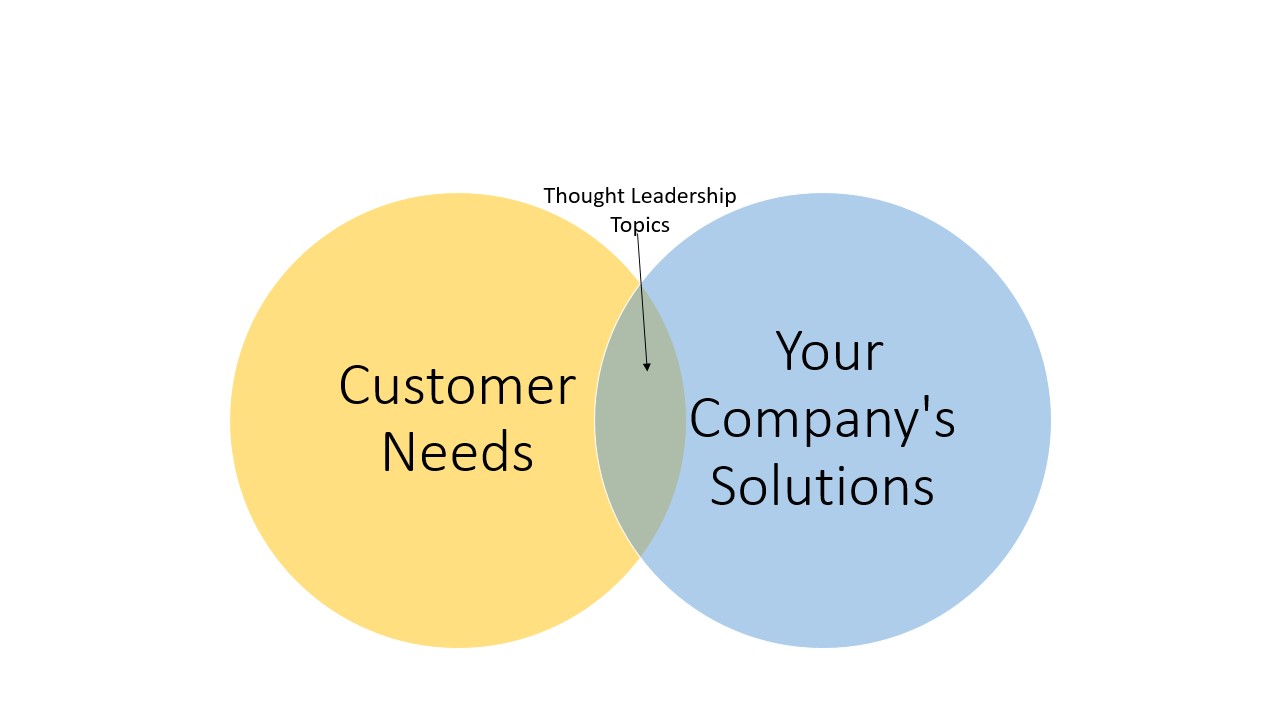Establishing a Thought Leadership Platform for Lead Generation and Beyond
Only writing content to drive sales means missing opportunities for lead generation. It’s as important to create a thought leadership platform to attract potential customers.
B2B organizations often see their bottom-of-the-funnel content – those eBooks and guides that convert leads to customers – as the most valuable content they create. In turn, organizations focus their budget and resources on the pieces that have the quickest and easiest path to measure ROI.
It’s easy to underfund or even overlook leveraging your subject matter experts (SMEs) for top-of-the-funnel content to attract and engage potential customers early in their decision-making process. Establishing a thought leadership platform to guide your content strategy can strengthen your organization’s content game.
Before your audience considers working with you, it’s crucial to earn their trust and establish credibility. As hard as it can be, that means focusing less on your company’s products and solutions and more on creating content about the challenges your target customers struggle with. Before they evaluate where to spend their money, your customers begin their journeys by trying to better understand their pain.
In today’s ROI-focused marketing world, investing in “thought leadership” can be a hard sell inside B2B organizations. But a focus on knowledge sharing and trust building at the top of the funnel — and setting aside the immediate expectation of making a sale – can position your SMEs as trusted resources in solving customer challenges.
Thinking through your thought leadership platform before creating content makes it easier to connect all the pieces in your funnel. Then, you leave a breadcrumb trail of content that earnestly answers your prospects questions. At each step if you build trust that you are there to answer their questions – not just sell them your stuff – prospects convert themselves from potential customers with problems reading a blog post to educated buyers excited they have picked you to solve their issues.
Top-of-the-funnel content aligned within your thought leadership platform demonstrates how your organization understands the problems your potential customers face and warms up prospects to consider your products and services to solve them. The best thought leadership content serves as an excellent resource for prospects that need to educate their colleagues about issues and align groups that share buying decision responsibility. It confronts your prospects’ assumptions that their challenges are unsolvable or that the status quo can never change. It reframes problems and builds trust through your SMEs that lead customers back to your company when they’re ready to solve their pain points.
How to Plan and Create a Strategic Thought Leadership Platform
To achieve the best results for a thought leadership platform that attracts customers, follow these steps to ensure the content delivers value early in the buyer’s journey without it being a purely academic exercise completely disconnected from the sales funnel.
1. Define your audience
As you plan engaging thought leadership content, start with learning as much as you can about the type of prospects most likely to enter at the top of your funnel and leave through the bottom. What do they care about? What are their biggest challenges? How do they search for solutions? Some questions to consider while you define your audience are:
- Which prospects have the highest potential for growth?
- Are the personas who look for content at the top of the funnel the same people who make the final buying decisions? Are they educating themselves or are they gathering info to advise a final decision maker?
- How do they search for solutions to problems?
- What are the potential solutions to their problems? (For B2B, it’s often not just you or your competitors. They could also fix it themselves or do nothing.)
2. Understand pain points
The best thought leadership platform is rooted in empathy. Draw on your experts’ experiences that show how they previously solved pain points for others, and use language that acknowledges the emotions customers are likely feeling early in the journey. To attract future customers to your products or services, create content that answers these questions:
- What problems keep your prospects from achieving their best results?
- Where is there confusion, doubt or an obstacle to their success?
- What new challenges are wreaking havoc on their industry?

3. Identify unique insights
The most powerful thought leadership platforms deliver unique insights that teach your customers something new about their challenges while leaving the first crumbs that lead back to your organization on their trail to solving problems. At Standing Partnership, for example, we help our clients develop unique insights by commissioning research with their customers or analyzing customer data to highlight how chosen solutions impact the problems they’re trying to solve.
If their challenge is increasing customer retention, use customer data to show retention or that “wallet share” changed after working with you for a year. If the challenge is employee retention or recruitment, highlight your customers having the most hiring success, share the best practices that led to this success, including (but not exclusively to) the way your products made it possible.
Unique insights must reveal something new to customers about their business and compel them to take action to change the status quo. Identify your distinctive insights by answering these questions:
- What are the leaders in your field discussing?
- What data or research do you have to build on or offer a new take?
- What unique data do you have to support your position or angle?
4. Content mapping, planning and development
Tackling the workload to create a thought leadership platform can seem overwhelming, which is why it’s important to organize your insights before diving into content development. Consider how your prospects consume content and where they go to understand pain points and solve their problems. Rather than plotting unique content for each channel and funnel step, think about how you can create a comprehensive piece, such as “The Complete Guide to Solving <Your Prospect’s Biggest Challenge>.” Then plot how to repurpose the content from the guide into bite-size chunks optimized for prospects for specific channels and funnel stages. This strategy shows customers how each piece connects to reach their final destination. Consider these questions as you map your content:
- What does the journey from understanding problems to considering solutions to making a purchase look like? What channels do customers use at each step? Do the number of people involved in a decision increase as you get closer to a decision?
- Where is the best place to start in building out the content, so you can show you’re making immediate progress, but it also allows you to build your trail of content breadcrumbs over time?
- Do you have the right internal resources to create this content or do you need to outsource at some point in the process? Do you need help with strategy, prospect research, writing, design, video, etc.?
Use some of these most effective thought leadership content titles to get started:
- Identify how to pick <your topic>
- 7 Tips to Overcoming <a challenge for your audience>
- When Is It Time to Decide <on product that leads back to you>?
- How to Compare <your product> vs. <hard to compare competitor>
- How to Estimate the Cost of <your topic>
5. Measuring Impact of Your Thought Leadership Platform
As you’re creating your content pieces, ask yourself: “What’s the next step our ideal customers would take to solve their pain?”
Then ask, “How will we know if this content helped them take that next step?”
Your favorite finance executive will be quick to remind you that it’s not enough for content to be high quality and tailored to your audience. All content, even thought leadership at the top of the funnel, should inspire actions that lead customers down a path of value to your organization. This could look like reading more articles on your site, sharing their email address for a newsletter or signing up for a free consultation. As you ask them to take more valuable steps for your organization, you need to deliver bigger value with content that has surprising or compelling information about their challenges.
Each content piece should have a call-to-action, such as directing the reader to start a conversation with sales, ask a question for more information, sign up for a newsletter or read another piece of content. Thought leadership can be the entry way to more sales-oriented pieces. Every few months look at downloads, click-through-rates and CTA conversions for each piece. Are they delivering what you expected? If not, focus on making one specific change that will improve performance in that lagging metric.
A successful thought leadership platform is about achieving growth. When you create high quality content that shows your expertise and unique insights to potential clients, the growth will come organically.
For more information, please contact inquiries@standingpartnership.com.

